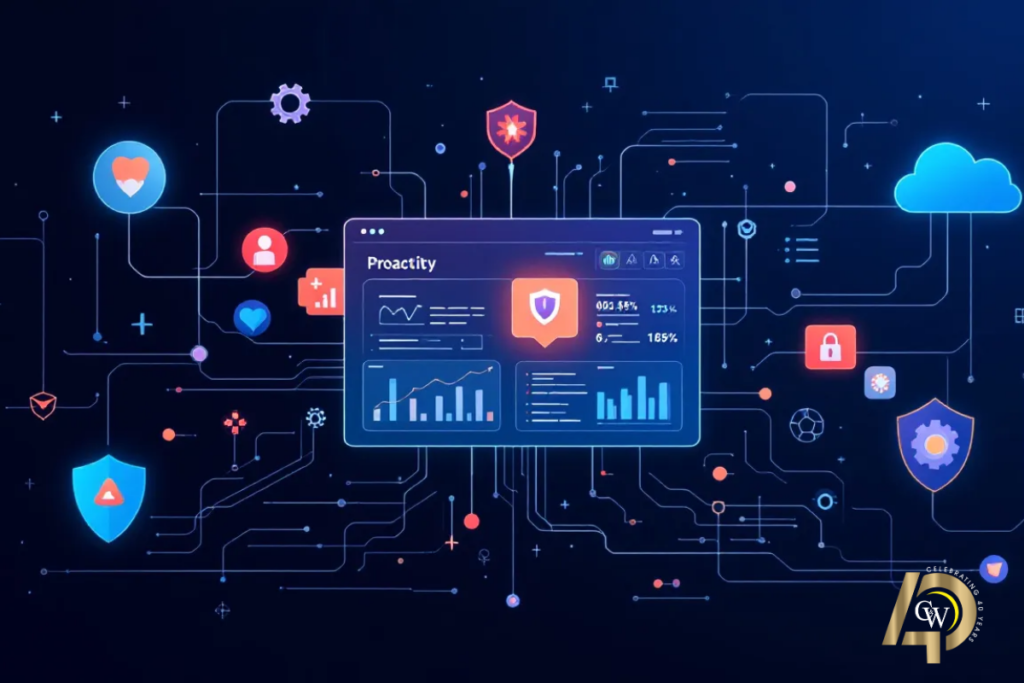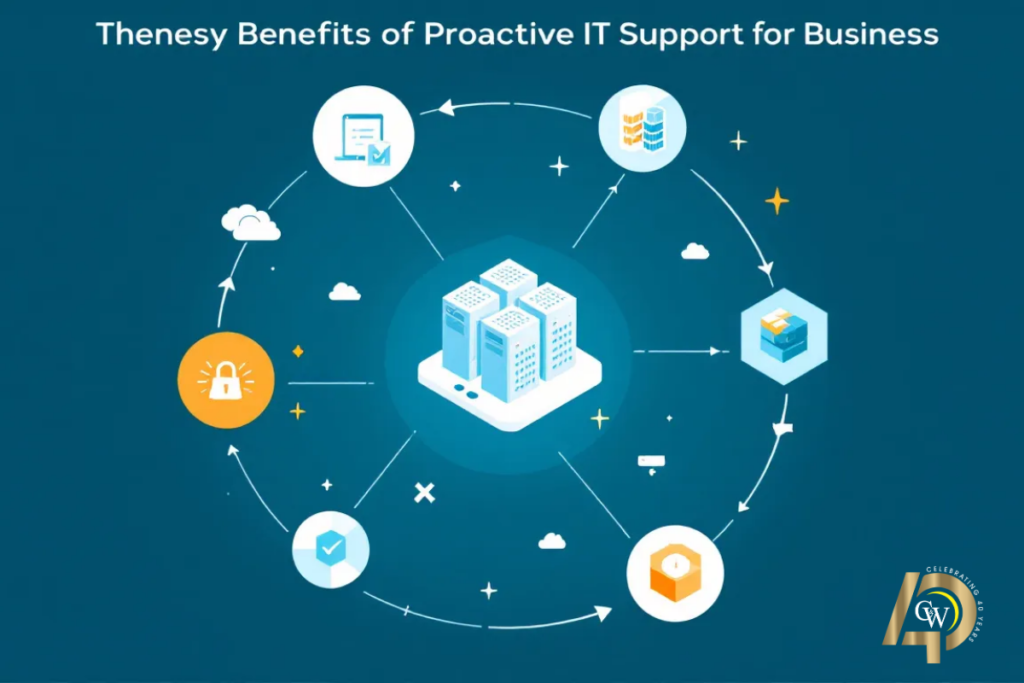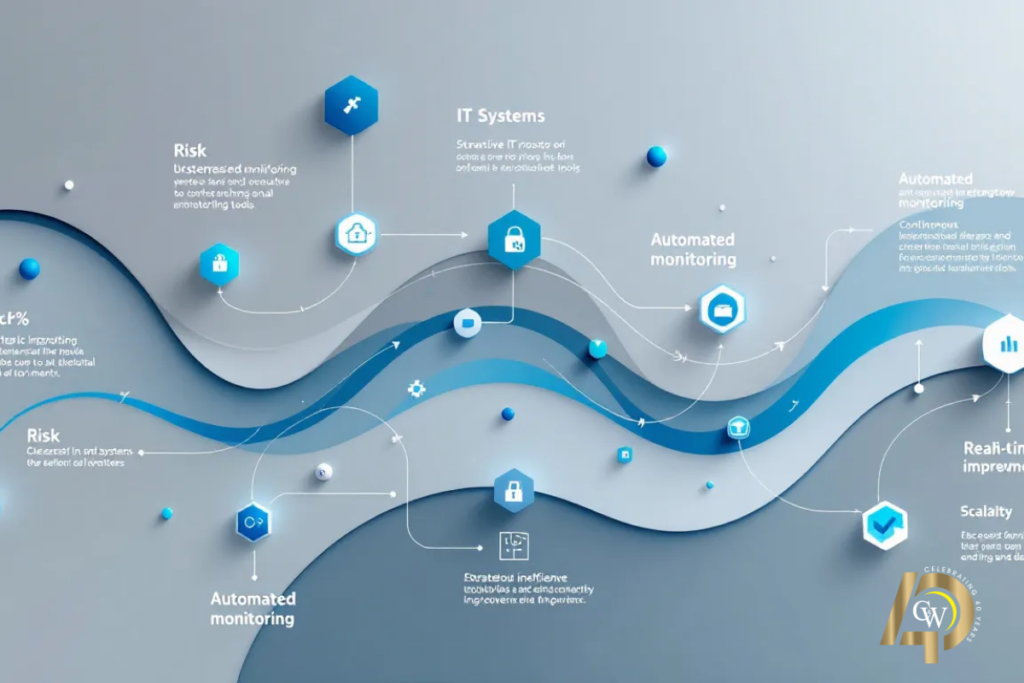Proactive IT anticipates and prevents IT problems before they disrupt your business. Unlike reactive IT, which only addresses issues after they occur, proactive IT focuses on continuous monitoring, regular updates, and comprehensive security measures to keep operations running smoothly. This forward-thinking approach not only minimizes downtime but also helps reduce costs by preventing expensive emergency fixes. By maintaining an up-to-date technology infrastructure and leveraging advanced tools, proactive IT enhances productivity, strengthens security against cyber threats, and supports overall business growth. This article explores how proactive IT can save costs, enhance productivity, and improve security, making it an essential strategy for modern businesses aiming to stay competitive and resilient.
Key Takeaways
Proactive IT anticipates and mitigates issues through continuous monitoring, regular updates, and a focus on cybersecurity, enhancing overall business efficiency.
Key advantages of proactive IT support include significant cost savings, increased productivity from reduced downtime, and enhanced security measures against cyber threats.
Implementing proactive IT requires choosing the right managed services provider, assessing expertise, evaluating service delivery, and fostering strong collaboration to ensure effective support.
Understanding Proactive IT
Proactive IT focuses on anticipating and mitigating issues before they disrupt business operations. Unlike reactive IT, which responds to problems after they occur, proactive IT emphasizes ongoing support, automated monitoring, and advanced security tools to maintain a seamless environment. This approach preempts potential issues and ensures your technology infrastructure aligns with business needs.
Key components of proactive IT include continuous monitoring, regular updates, and a zero-trust approach to cybersecurity. Incorporating tools like automated responses and managed DNS-based protection allows proactive IT teams to prevent issues from arising.
This holistic approach to managed services focus on strategic guidance and expert advice tailored to your current needs, ensuring robust security and optimal performance.
Key Advantages of Proactive IT Support
The benefits of proactive IT support are manifold. Adopting a proactive approach enables businesses to achieve significant cost savings, increased productivity, and enhanced security. Proactive IT helps in preventing problems, ensuring a smoother operation, and fostering an innovative and secure organizational environment.
Cost Savings
One of the most compelling benefits of proactive IT support is cost savings:
It allows businesses to benefit from predictable fixed-cost monthly billing, making budgeting more manageable.
Identifying and addressing potential issues before they escalate reduces emergency expenses.
It minimizes downtime, ultimately saving more money.
Additionally, proactive IT security assessments offer financial advantages by being more cost-effective compared to fixing major issues post-breach. Optimizing resource allocation through proactive planning leads to substantial IT cost reductions, allowing businesses to invest more in growth and innovation rather than firefighting IT problems.
Increased Productivity
Proactive IT support ensures continuous operations, allowing businesses to maintain and even boost their productivity levels. Addressing potential issues early ensures a smoother user experience and reduces interruptions. This proactive approach aligns with the needs of most businesses, leading to more opportunities for growth and success.
The integration of advanced technology, such as AI, further enhances productivity by providing personalized user experiences and adaptive systems. Business leaders who invest in proactive IT support can expect significant improvements in their business processes and overall efficiency.
Enhanced Security
Security is paramount in today’s digital age. Proactive IT support includes diligent security monitoring and real-time detection of unusual activity to prevent breaches. Tools like User Behavior Analytics (UBA) and Security Information and Event Management (SIEM) are instrumental in identifying potential threats and sending alerts for immediate action.
Automated patching and managed anti-malware solutions keep systems secure and updated, reducing cyberattack risks. Additionally, DNS-based protection ensures that web addresses accessed by users are safe from compromise, guarding against phishing attacks and enhancing data protection.
Regular employee training on cyber security awareness is also crucial for recognizing risks and responding appropriately to potential security breach.
Implementing Proactive IT in Your Organization
Implementing proactive IT involves continuous monitoring, regular updates, and employee training to ensure your technology infrastructure remains secure, efficient, and up to date.
Features like 24/7 monitoring, maintenance, and management are essential for access break fix support preventing problems before they happen.
Continuous Monitoring
Continuous automated monitoring is crucial in proactive IT support because:
It enables real-time detection of unusual activities.
It allows IT teams to respond quickly and effectively.
Tools that provide real-time alerts help IT staff address potential issues promptly.
It reduces the risk of security incidents.
It ensures smooth operations.
With the integration of AI and machine learning, continuous monitoring becomes even more powerful. These technologies analyze data in real-time, identify patterns, and predict issues before they escalate. This not only enhances the efficiency of IT operations but also significantly reduces the response time to potential threats.
Regular Updates and Maintenance
Regular updates and maintenance keep IT systems secure and efficient by:
Minimizing security vulnerabilities through a consistent update schedule
Ensuring all software and systems function smoothly
Maintaining server and network efficiency and safety through proactive patching and updates
Preventing problems before they occur
Keeping systems up to date helps businesses achieve optimal performance and reduce downtime. This ongoing support protects against vulnerabilities and potential attacks while ensuring your technology infrastructure meets business needs.
Employee Training
Employee training is a vital component of proactive IT. Frequent sessions keep employees aware of the latest cybersecurity threats and how to respond effectively. This mitigates the risk of security breaches and enhances overall productivity and efficiency.
Equipping internal IT staff and other employees with necessary knowledge and skills creates a more secure and resilient IT environment. This proactive training ensures your team is prepared to handle potential IT issues and threats, benefiting the entire organization.
Choosing the Right Managed IT Services Provider
Selecting the right managed IT services provider is crucial for effective proactive IT support for customers. This involves assessing the provider’s expertise and experience, evaluating their service delivery models, and building strong relationships.
This ensures local businesses’ specific needs are met and they receive the necessary support to maintain a secure and efficient technology infrastructure.
Assessing Expertise and Experience
Researching a managed IT services provider’s expertise and experience is essential. Key factors include services offered, service level agreements (SLA), and costs. Understanding these elements helps identify a provider who can deliver tailored proactive support for your business needs.
Knowing the specific services offered and your responsibilities in the partnership is vital for successful collaboration. This ensures both parties have clear expectations and can work together effectively to achieve desired outcomes. It is beneficial to work closely with an IT partner who you can trust.
Evaluating Service Delivery
Evaluating potential IT support providers’ service delivery models is crucial. This involves understanding aspects like support availability, the scope of services provided, and the overall delivery model. This ensures the provider can meet your business needs and deliver the required level of support.
Understanding the services you’ll receive and your responsibilities in the partnership helps manage expectations and ensures smooth collaboration between your organization and the managed IT services provider.
Building Relationships
Building strong relationships with your IT support team is essential for effective collaboration. Establishing trust and rapport with your IT provider enhances communication and helps manage expectations effectively. This strong partnership ensures both parties work together seamlessly to achieve common goals.
Effective collaboration and communication lead to better expectation management within IT support. This enhances overall service delivery and ensures your organization stays organized and prepared for any IT challenges.
Future Trends in Proactive IT
As technology evolves, proactive IT systems are becoming more robust and adaptable. Future trends include:
Increased use of AI and machine learning
Expansion beyond traditional IT to include cloud environments
Inclusion of edge computing
Integration of IoT devices
These advancements transform how businesses operate and enhance the reliability and security of their technology infrastructure, setting an industry standard.
Artificial Intelligence and Machine Learning
Artificial intelligence (AI) and machine learning (ML) revolutionize proactive IT by enabling real-time data analysis, pattern identification, and predictive maintenance. These technologies detect anomalies and automate remediation tasks, significantly reducing response time to potential IT issues. Leveraging AI and ML enhances operational efficiency and improves cybersecurity posture.
Integrating AI tools in proactive IT support allows companies to act before issues escalate, ensuring a more stable and secure IT environment. This advanced technology helps maintain a healthy technology infrastructure and supports overall digital transformation.
Expansion Beyond Traditional IT Environments
Proactive IT is no longer confined to traditional IT environments. The rise of IoT devices, and increasing adoption of cloud environments and edge computing systems require more complex proactive management strategies. These new environments necessitate developing decentralized operational models to handle diverse data sources effectively.
This expansion signifies a broader scope for proactive IT support. As mid-sized businesses undergo digital transformation, the need for advanced technology and robust management of these new environments becomes paramount. This trend drives the evolution of proactive IT, making it integral to modern business operations.
Summary
Proactive IT support offers numerous benefits, including cost savings, increased productivity, and enhanced security. By adopting a proactive approach, businesses can ensure continuous operations, prevent potential issues, and maintain a secure and efficient technology infrastructure. Implementing proactive IT involves continuous monitoring, regular updates, and employee training, all of which contribute to a more resilient and productive organization.
Looking ahead, the integration of AI and machine learning, as well as the expansion beyond traditional IT environments, will continue to shape the future of proactive IT. These advancements will enable businesses to stay ahead of potential issues, enhance their cyber security, and drive innovation. Embracing proactive IT support is not just a smart business decision—it’s an investment in the future success and stability of your organization.
About C&W Technologies
C&W Technologies is a leading technology company that specializes in delivering innovative software solutions for businesses and consumers. We are committed to providing high-quality products that help our customers streamline their processes, increase efficiency, and improve overall performance. Our team of skilled professionals has a deep understanding of the latest technologies and constantly strives to stay ahead of trends and advancements in the industry. With years of experience under our belt, we have successfully delivered cutting-edge solutions to clients from various industries. At C&W Technologies, we prioritize building strong relationships with our clients, as we believe that trust and communication are key to delivering successful projects. Let us help you with your IT cost savings today by contacting us!
Contact Us Today!
If you are looking for a reliable and innovative technology partner, look no further than C&W Technologies. Contact us today to learn more about our services and how we can help you achieve your goals.
Frequently Asked Questions
What is proactive IT?
Proactive IT is an effective approach to IT management that emphasizes anticipating and resolving potential issues before they occur, which helps maintain continuous operations and improve security. This method fosters a more resilient IT environment.
How does proactive IT support save costs?
Proactive IT support significantly reduces costs by providing predictable monthly billing, minimizing emergency expenses, and optimizing resource allocation through strategic planning. This approach not only enhances efficiency but also fosters financial stability for your organization.
What are the key components of implementing proactive IT in an organization?
Implementing proactive IT in an organization requires continuous monitoring, regular updates and maintenance, and employee training to foster a secure and efficient IT environment. Prioritizing these components can significantly enhance your organization’s IT resilience.
How do AI and machine learning enhance proactive IT?
AI and machine learning enhance proactive IT by enabling real-time data analysis and predictive maintenance, which improve efficiency and effectiveness in support tasks. This proactive approach helps organizations anticipate issues before they escalate.
Why is building strong relationships with your IT service provider important?
Building strong relationships with your IT service provider is crucial as it fosters collaboration, improves communication, and aligns expectations, which collectively enhance the management of IT support and overall operations. This connection can significantly benefit your organization’s efficiency and effectiveness in IT services.




